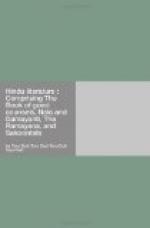The western world has as yet only received the “Mahabharata” in fragments—mere specimens, bearing to those vast treasures of Sanscrit literature such small proportion as cabinet samples of ore have to the riches of a mine. Such knowledge as we have of the great Indian epics is largely due to Sir William Jones, and the host of translators who followed him.
In its present shape the “Mahabharata” contains some two hundred thousand verses. The style is forcible, often terse and nervous: the action is well sustained, and the whole effect produced is that of a poem written in commemoration of actual conflict between members of rival clans who lived somewhere southeast of the Punjab. In portrayal of character the Hindoo poem somewhat resembles its Grecian counterpart—the “Iliad”; the noble devotion and chivalric character of its chief hero, Arjuna, reminds us of Hector—and the wily, sinful Duryodhana, is a second Ulysses. The “Mahabharata” was probably begun in the third or fourth century B.C., and completed soon after the beginning of the Christian era.
The “Bharata” war is a war between rival cousins of the house of Bharata, a race of heroes mentioned in the Rig-veda collection. Duryodhana deprives his cousin Yudhisthira of his throne by inducing him to squander his fortune, kingdom, family, and self—and then banishes Yudhisthira and the latter’s four brothers for twelve years. The gambling was conducted in an unfair manner, and the cousins feel that their banishment was the result of treachery, although pretended to be mercy in lieu of death. When the twelve years are over they collect armies of sympathizers, and on the Sacred Plain of the Kurus (the Holy Land of India) the great war is fought out. The good prevails, Duryodhana is slain, and Yudhisthira recovers his kingdom. This story is told so graphically that the “Mahabharata” still has the charm that comes from plot and action, as well as that of poetic beauty.
A concluding passage of this great poem says: “The reading of this ‘Mahabharata’ destroys all sin and produces virtue, so much so that the pronunciation of a single shloka is sufficient to wipe away much guilt. It has bound human beings in a chain, of which one end is life and the other death. If a man reads the ‘Mahabharata’ and has faith in its doctrines, he is free from all sin and ascends to heaven after his death.”
The present selection is the episode of Nala and Damayanti. It is one of the most charming of the “Mahabharata” stories, and its Oriental flavor and delicacy have been well preserved by the translator, Sir Edwin Arnold.
L.F.C.
THE MAHABHARATA
NALA AND DAMAYANTI
Part I




